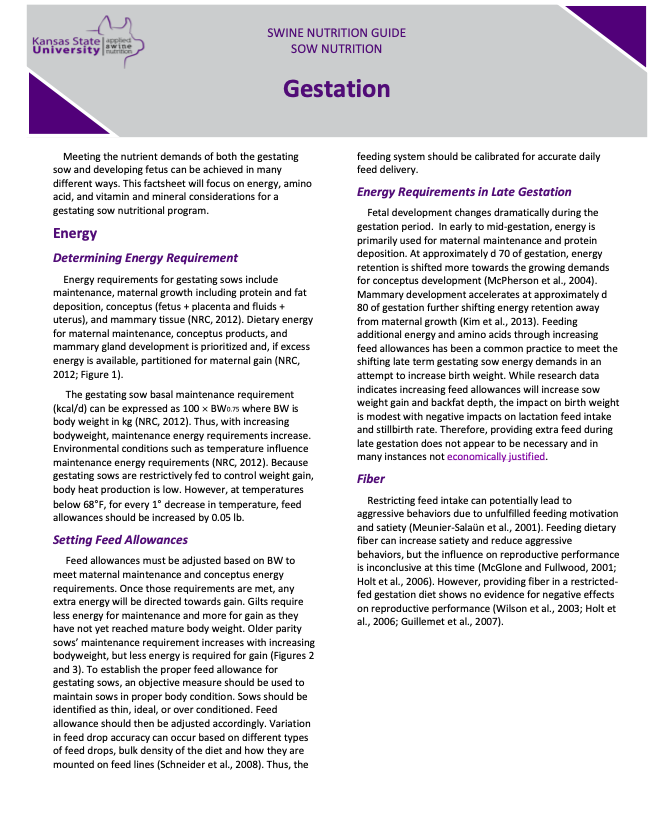Energy
Determining Energy Requirement
Energy requirements for gestating sows include maintenance, maternal growth including protein and fat deposition, conceptus (fetus + placenta and fluids + uterus), and mammary tissue (NRC, 2012). Dietary energy for maternal maintenance, conceptus products, and mammary gland development is prioritized and, if excess energy is available, partitioned for maternal gain (NRC, 2012; Figure 1).
The gestating sow basal maintenance requirement (kcal/d) can be expressed as 100 ´ BW0.75 where BW is body weight in kg (NRC, 2012). Thus, with increasing bodyweight, maintenance energy requirements increase. Environmental conditions such as temperature influence maintenance energy requirements (NRC, 2012). Because gestating sows are restrictively fed to control weight gain, body heat production is low. However, at temperatures below 68°F, for every 1° decrease in temperature, feed allowances should be increased by 0.05 lb.
Setting Feed Allowances
Feed allowances must be adjusted based on BW to meet maternal maintenance and conceptus energy requirements. Once those requirements are met, any extra energy will be directed towards gain. Gilts require less energy for maintenance and more for gain as they have not yet reached mature body weight. Older parity sows’ maintenance requirement increases with increasing bodyweight, but less energy is required for gain (Figures 2 and 3). To establish the proper feed allowance for gestating sows, an objective measure should be used to maintain sows in proper body condition. Sows should be identified as thin, ideal, or over conditioned. Feed allowance should then be adjusted accordingly. Variation in feed drop accuracy can occur based on different types of feed drops, bulk density of the diet and how they are mounted on feed lines (Schneider et al., 2008). Thus, the feeding system should be calibrated for accurate daily feed delivery.
Energy Requirements in Late Gestation
Fetal development changes dramatically during the gestation period. In early to mid-gestation, energy is primarily used for maternal maintenance and protein deposition. At approximately d 70 of gestation, energy retention is shifted more towards the growing demands for conceptus development (McPherson et al., 2004). Mammary development accelerates at approximately d 80 of gestation further shifting energy retention away from maternal growth (Kim et al., 2013). Feeding additional energy and amino acids through increasing feed allowances has been a common practice to meet the shifting late term gestating sow energy demands in an attempt to increase birth weight. While research data indicates increasing feed allowances will increase sow weight gain and backfat depth, the impact on birth weight is modest with negative impacts on lactation feed intake and stillbirth rate. Therefore, providing extra feed during late gestation does not appear to be necessary and in many instances not economically justified.
Fiber
Restricting feed intake can potentially lead to aggressive behaviors due to unfulfilled feeding motivation and satiety (Meunier-Salaün et al., 2001). Feeding dietary fiber can increase satiety and reduce aggressive behaviors, but the influence on reproductive performance is inconclusive at this time (McGlone and Fullwood, 2001; Holt et al., 2006). However, providing fiber in a restricted-fed gestation diet shows no evidence for negative effects on reproductive performance (Wilson et al., 2003; Holt et al., 2006; Guillemet et al., 2007).
